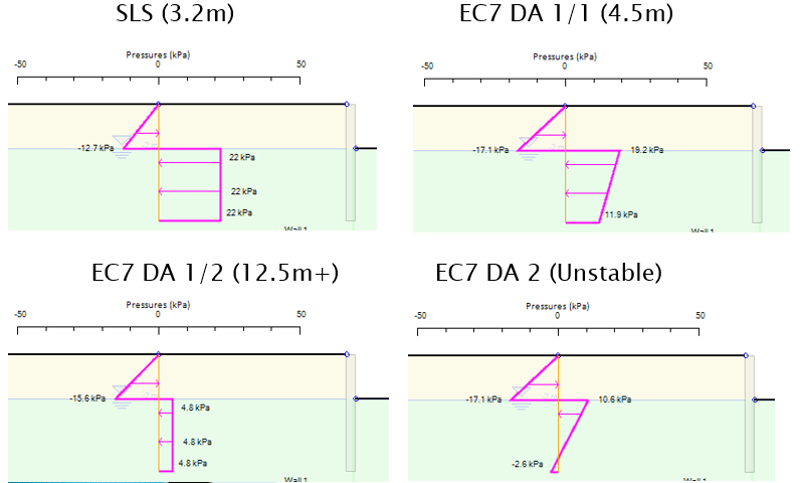Deficiencies of Geotechnical Eurocode 7 Part 1 set to remain and why you should revolt
Geotechnical Eurocodes are set to get updated with a major overdue revision. Eurocode 7 traditionally specified design approaches with partial factors that would theoretically capture different ultimate limit states.
Some of these combinations are geared towards a structural limit state (STR) while others are targeted towards a geotechnical limit state (GEO).
For the easy part, the proposed update introduces a long overdue importance factor that typically ranges from 0.9 for less important/temporary projects to 1.1 for critical facilities.
In the STR approach things are quite straightforward.
The old and proposed editions allow for a standardized analysis of a deep excavation and for results to be amplified at the very end of the analysis. Essentially, this approach allows us to run an equivalent allowable stress approach and amplify results at the very end.
In the GEO approach, Eurocode 7 persists on the M2 approach which essentially reduces soil strengths. Typical reductions are essentially unchanged, 1.25 on the tangent of the effective friction angle and on the effective cohesion, and 1.4 on the undrained shear strength of clays.
While these adjustments could be reasonably used in a slope stability problem, a single pile analysis, their inclusion in complex soil structure modelling is totally inappropriate especially for deep excavations.
Historically, the M2 approach originated from engineers with experience in stiff London clays where the reducing the undrained shear strength by 1.4 made little practical different.
In other parts of the world, where excavations are deeper, soils are softer, and stage effects are more important, strength reduction and soil-structure interaction are fundamentally incompatible.
In many cases reducing the soil strength of an existing slope would render the slope numerically unstable.
In soft clay situations such as in the Netherlands, reducing the undrained shear strength of an already soft clay by 1.4 would render all excavations and conditions unstable, both in conventional and in a non-linear analysis.
As we had documented in numerous workshops, the strength reduction approach severely punishes wall bending moments in multilevel braced deep excavations.
Typically, M2 approaches tend to produce a safety factor of about two on wall bending and closer to 1.35 for supports (Tables 1, 2 and Figures 1, 2).
As most excavations collapse happen due to support overstress and not due to wall bending failures, the M2 results are both overconservative on bending moments and potentially unsafe on brace reactions.
Figure 3 contrasts the obtained wall embedment and net loading diagrams for a 1.8m deep excavation in soft clay.
EC7 DA1/2 combinations with M2 would require a 12.5m wall embedment vs. the 3.2m wall embedment for a traditional SLS approach.
Such a large discrepancy constitutes a clear code deficiency.
Table 1: Excavation Analysis Comparison between SLS, AASHTO, and EC7 Combinations for a 16m deep excavation in sands

Table 2: Excavation Analysis Comparison between SLS, AASHTO, and EC7 Combinations for a 16m deep excavation in clay


Figure 1: DeepEX model with sands

Figure 2: DeepEX model with clay at base

Figure 3: Comparison of net loading diagrams and required wall embedment for various design scenarios
A little provision on determining soil strength recommends defining soil strength at the most conservative of the lower or upper 5% on the strength distribution (5% or 95%).
While in principle this appears to be a rational approach, the recommendation can have significant impact on future designs depending on how the soil strength variation is.
If for example strength variation is along longitudinal sections, then the lower estimate can be reasonably expected to be encountered.
However, if the strength variation is simply random then the 5% lower bound can lead to unreasonably conservative analysis results especially when compounded with the M2 approach.
If you are practicing in the European Union you still have the time to make a difference before the new provisions take effect.
Reach out to the reviewing board, comment, and request that these significant code deficiencies be addressed.

